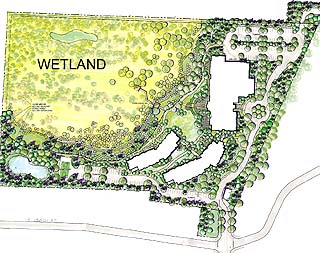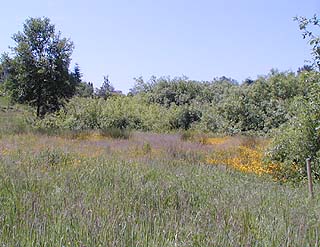
Surveys
DJC.COM
July 17, 2003
Development can be beneficial to wetlands
GGLO

Cedarbrook’s wetland plan included engineered soil, storm water management and re-vegetation.
|
Development and wetland restoration can be a successful collaboration.
Often, it seems that development goals for a particular site are in direct opposition to the preservation of that site’s natural habitat, particularly wetlands. But that is not always the case. A development project can actually create an opportunity to restore a degraded wetland.
Pavement, people and pollution can directly harm a wetland environment, but invasive plants can do damage as well. A wetland is defined by its soil, plants, and the presence of surface water or saturated soils. Many things can disrupt the hydrology and habitat of a wetland, including altered storm water and groundwater patterns, disturbed soils and non-native plant species.
Development of a site adjacent to a declining wetland can initiate the restoration process and prevent further decline. A case study of the 7-acre wetland restoration accomplished at the Washington Mutual Leadership Center at Cedarbrook in SeaTac provides insight into the mitigation process and illustrates some effective solutions.
The process
The first step is to gain an understanding of the regulatory requirements at the federal, state and local levels.
The Federal Clean Water Act, state Department of Ecology and city of SeaTac regulations, for example, dictate that a development in proximity to a wetland must follow a detailed wetland mitigation plan. As part of the mitigation requirements, a buffer must be established between the proposed development and the restored wetland. Disturbances resulting from development must be mitigated, and a monitoring and maintenance plan must be implemented. Finally, the proposed project must not impact the existing wetland beyond an acceptable regulatory level.
A certified wetland biologist must assess the current conditions, delineate the wetland boundaries, identify the wetland functions and establish a mitigation approach. Contrary to common perception, wetlands are not always marshes. There are four different wetland habitat types in the Pacific Northwest — forested wetlands, scrub-shrub wetlands, emergent wetlands and aquatic bed wetlands.
Non-native, invasive plants are often a source of wetland degradation. Urbanization typically leads to increased surface run-off and pollutants, decreased groundwater and disrupted soils. Introduced species thrive in these disturbed conditions, out-competing natives, and compromising a wetland’s hydraulic functions. A plan for invasive plant removal, with minimal further damage to the existing native plants and soils, is essential to the viability of the restoration.
A maintenance plan is also required. All of the effort to eradicate invasive species and reintroduce natives must be diligently nurtured, cultivated and monitored to ensure long-term results.
A final wetland mitigation plan includes wetland delineation, approved buffer widths, preliminary planting design, proposed grading and drainage, and a monitoring plan. This plan reintroduces appropriate native species, reinforces the natural ecology of the site and raises the quality of wildlife habitat.
Public agencies, wetland scientists, biologists, native plant nurseries and contractors who specialize in wetland restoration are invaluable resources and an important part of the mitigation process.
All of these measures can be expected on any wetland restoration effort. But each wetland, like each site development, requires specific solutions. A few of the significant issues we encountered at the Washington Mutual Leadership Center at Cedarbrook, and our approach to their solutions, are described below.
Solutions at Cedarbrook

Graphics courtesy of GGLO
A restored meadow within the wetland.
|
The site that Washington Mutual chose for its corporate leadership center is in the heart of the city of SeaTac. About 40 percent of the site was an existing class A wetland which had been degraded over time by the harvesting of its peat soil, chemical and animal agricultural practices, and invasion by non-native plants.
Washington Mutual saw in the wetland the potential of creating a long lasting public amenity. The extensive mitigation process was undertaken by a team led by GGLO, which included SvR, Cooke Scientific Services, Soil Dynamics, and Restoration Logistics.
Soils: Construction on the upland portion of the site was impacted by spongy soils with a high clay content that resisted the necessary compaction. As a result, the existing soil was excavated in favor of imported structural fill. The imported fill solved construction issues but presented a problem for the proposed adjacent wetland buffer.
The fill material lacked the nutrients and water holding capacity for native plants to thrive. Slopes adjacent to the buffer were at maximum tolerances, and a typical topsoil layer at the required minimum depth would only invite erosion. The design team was concerned with the aesthetic impacts and cost implications of retaining walls or traditional erosion control measures.
The solution was an innovative approach known as “bio-stable living soil,” an engineered soil designed to eliminate erosion from precipitation. Compost tea was carefully developed to add beneficial and essential microorganisms to the soil and plants.
Storm water management: In order to minimize point source storm water flows from the new buildings, roof drains fed into level spreaders, providing a drainage pattern similar to pre-development conditions.
Re-vegetation: Non-native, invasive plants including Himalayan blackberry, Scotch broom, reed canary grass, yellow iris and purple loosestrife had established themselves within the wetland. The first phase of the re-vegetation process called for the removal of these undesirable species. Designated plants had to be hand cut, topped at 3 inches above the ground and their stalks carefully wiped with glyphosphate, an approved product. Large equipment was potentially damaging to the wetland soils, consequently all work was done by hand.
Finally, ecology and aesthetics were addressed in a striking planting design. A mix of native plants, grown in the Puget Sound basin, were selected based on studies of pre-disturbance conditions in the wetland and were installed in forest, meadow and thicket patterns that previously existed. Plant species provide habitat for wildlife as well as compatibility with species being utilized within the developed portion of the site.
Finding a balance between the demands of growing populations and the needs of natural places is challenging. But projects like the wetland restoration at Cedarbrook show that it can be done in a way that serves private and public interests alike.
Mark Sindell is a landscape architect with GGLO, a multi-disciplinary design firm in Seattle.
Other Stories:
- Battle over keeping dams rages on
- What’s your vision for Seattle’s future?
- Hat Island gets a drink from the sea
- Foss Waterway cleanup kicks into high gear
- Reclaimed water — a ‘new’ water supply
- LOTT dives into reclaimed water
- Clean air: saving our competitive advantage
- Europe points the way to sustainability
- Old maps handy for site investigations
- Planning for an environmental emergency
- Engineered logjams: salvation for salmon
- Pierce County maps where its rivers move
- Be prepared with a spill management plan
- Check out properties with microbial surveys
- Sculpting a park out of a brownfield
- Charting a sustainable course for the Sound
- Water rights no longer a hidden asset
- The economics of sustainability
- Laying the path for responsible education
- Squeezing more out of renewable energy
- Controlling mosquitos and the environment
- Beavers back in force in the Seattle area
- Our future: no time or resources to waste
- Port Townsend dock promotes fish habitat
- Brownfields program is here to stay
- Master Builders teaches green homebuilding
- A salmon-friendly solution on the Snake
Copyright ©2009 Seattle Daily Journal and DJC.COM.
Comments? Questions? Contact us.